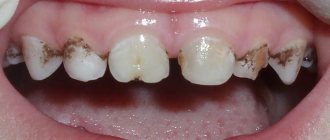External signs of a sore throat
The condition of the oral cavity is influenced by the environment, past diseases, and inhaled microbes, so an absolutely healthy pharynx is rare. According to statistics, by the age of seven, almost every child suffers from various chronic throat diseases. You can determine whether the throat is affected or not by the following signs:
- The tonsils become red and increase in size, swollen follicles are clearly visible on them, which are sometimes filled with pus, and there is a white, yellowish or gray coating. With herpetic tissue damage, blisters and small ulcers form.
- The soft palate becomes inflamed and a rash may appear on it.
- The back wall of the pharynx looks swollen, loose, the follicles are enlarged. Upon examination, a pronounced network of small vessels can be detected. The presence of ulcers indicates infection with the herpes virus (see also: symptoms of herpes on the tonsils in a child). The tongue is hyperemic.
- The tongue is coated. If it has a brown or gray tint, affecting the tongue and teeth, this may indicate chronic pharyngitis.
Adenoiditis
A disease of inflamed tonsils of the pharynx, which is provoked by various viruses. It manifests itself as a dry cough, severe headache and attacks of shortness of breath. Common in children under 14 years of age.
The disease occurs when the immune system is weakened and there is a lack of vitamin D.
- Burning in the throat - what could it be;
- Inflammation of the tonsils - symptoms;
- A lump appeared in the throat near the Adam's apple - what could it be?
Signs of a sore throat
The first symptoms of throat diseases are pain and other discomfort. The child will begin to complain of discomfort when swallowing and speaking. You may experience a cough, runny nose, difficulty breathing, fever, or chills. Upon examination, parents may notice:
- redness and swelling of the posterior wall of the pharynx and soft palate;
- tonsillitis;
- the presence of small bubbles, after breaking through which ulcers form;
- presence of mucus or pus;
- the formation of caseous plugs - white balls on the back surface of the larynx that interfere with swallowing.
A red throat and enlarged tonsils indicate the development of a sore throat or other infectious disease (for more details, see the article: treatment of a red throat in an infant)
READ ALSO: photo of a sore throat in the mouth of children
Depending on the type of pathology, the symptoms will vary. A red throat can indicate both a common acute respiratory infection and serious pathologies that require qualified help.
READ IN DETAIL: How to treat a red throat in a child?
Diagnostics
Whether the patient has a throat disease or not, only a specialist can answer this question. The first step to identifying all problems with the throat is a visit to the otolaryngologist's office, where a differential diagnosis will be carried out. If in doubt, the doctor will prescribe a further examination, which includes:
- survey (collecting anamnesis). The doctor questions the patient in detail, determining the main complaints and the duration of the disease, if any. The doctor is interested in literally everything, even stressful situations that can cause, for example, aphonia;
- performing rhinoscopy (standard examination). Upon examination, pathological processes in the nasopharynx are detected;
- endoscopic rhinoscopy – therapeutic and diagnostic manipulation (allows for minimally invasive surgical interventions);
- X-ray examination of the maxillary sinus and other sinuses. Thanks to x-rays, acute and chronic foci of infection are determined;
- general blood and urine analysis . Particular attention is paid to indicators such as ESR and leukocyte count. Their increase indicates an inflammatory process. If band neutrophils are also elevated in the analysis, we are talking about an acute infection;
- bacterial culture from the nasopharynx . The results of the study allow us to determine which infection causes inflammation in the throat. Staphylococci take the lead in sowing; they inseminate the nasopharynx and lead to various diseases of the nose and throat. In second place are streptococci, and they are not inferior in insidiousness. For example, streptococcal tonsillitis often causes complications in the heart (myocarditis) and joints.
The functions of the tonsils and their appearance are normal
Before diagnosing throat diseases, it is necessary to familiarize yourself with general information about the functions and appearance of the tonsils. These formations are accumulations of lymphoid tissue and are often called tonsils.
- Red throat in a child: how to treat it at home if it constantly hurts and hurts to swallow?
Tonsils perform two main functions: protective and hematopoietic. They produce antibodies that fight pathogenic microorganisms, preventing them from entering the body. The tonsils also form lymphocytes - cells of the immune system.
A healthy person has 4 tonsils: 2 paired and 2 unpaired, they are located at the junction of the nasopharynx and pharynx. Normally, these formations are the size of a walnut and are colored light pink. Also signs of normal tonsils include:
- absence of redness and plaque;
- the mucous membrane is not inflamed, there is no pronounced vascular pattern;
- the tonsils do not come into contact with the palatine arches and do not extend beyond them;
- When pressing on the tonsils with a medical spatula, no pus or mucus is released.
The combination of all these signs indicates a person’s health. However, for some people, increased size of the tonsils is the norm - this is an individual characteristic of the body.
Tonsillitis - what it looks like (photo)
Tonsillitis is inflammation of the palate that occurs due to frequent sore throats. It occurs in acute or protracted form. This disease is most often not accompanied by elevated body temperature. There is starvation of lymph tissue, which causes problems with the respiratory functions of the body. Loss of voice and hoarseness can occur due to hormonal imbalances.
General rules for treatment
Self-medication is strictly prohibited. If parents discover a red throat in a child, it is necessary to contact a specialist to clarify the diagnosis and prescribe a course of treatment. READ ALSO: A child has a red throat: how to treat inflammation at home?
Medication approach
Depending on the disease, the doctor prescribes medications to relieve inflammation. Medicines, especially antibiotics, cannot be selected independently - many of them have serious side effects. The following agents are used in therapy:
- For bacterial infections of the pharynx and sore throat, the antibiotics Augmentin and Amoxicillin are used.
- The drugs Umkalor, Tonsilgon and Lymphomyosot have antimicrobial and antiviral properties (for more details, see the article: Tonsilgon drops: instructions for use for children under one year old). They are available in the form of drops, which is convenient for treating small children. The remedies fight the disease, eliminate unpleasant symptoms and help improve immunity.
- For herpes and other types of viral infections, interferons, Tamiflu, Remantadine, Lavomax, Acyclovir are prescribed.
- If the disease is caused by fungi, the specialist prescribes Fluconazole or Levorin (we recommend reading: instructions for use of Fluconazole for children).
- For redness of the throat caused by an allergic reaction, antihistamines (Xyzal, Cetrin, Ebastine, Zyrtec) are prescribed. It is necessary to completely exclude the baby’s contact with the irritant.
- If a nonproductive cough is added to the redness of the throat, drugs to thin and remove mucus - Prospan, Ambroxol, etc. - are included in the treatment regimen.
- To reduce body temperature and relieve pain, Nurofen and Paracetamol are used.
Local treatment for a sore throat
To relieve the symptoms of the disease, topical agents are often used:
- Sprays Tantum Verde, Ingalipt, Bioparox, Chlorophyllipt act as antiseptics (we recommend reading: Tantum Verde spray: analogues of the drug for children). The drug sprayed onto the mucous membrane reduces pain and softens the throat. Active components fight pathogenic flora.
- Tantum Verde and Septolete lollipops have a “cooling” effect and reduce pain. Excellent help with dry cough and sore throat. By sucking the lozenges and swallowing saliva, the child removes the mucus accumulated in the throat.
- Miramistin solution, as well as the preparations Tanin (1-2%) and Antiformin are antiseptics used for gargling. Regular procedures gradually clear the mucous membrane of plaque. The active substances in the solutions destroy pathogens and relieve inflammation.
- Silver Nitrate solution 0.25% or Lugol's - for periodic lubrication of the tonsils (we recommend reading: how to use Lugol's as a spray for children?). Used to relieve inflammation and reduce pain.
- A solution of salt and soda with the addition of a few drops of iodine or chamomile decoction reduces discomfort and acts as an antiseptic.
- Compress made of rye flour, honey and vegetable oil. Mix the mixture until it has the consistency of dough, heat it in a water bath and apply it to the sore throat for 20 minutes. The product relieves swelling, inflammation and pain.
Type of pharynx with Laryngitis
The disease affects the larynx and can occur in both chronic and acute forms. It can be triggered by exposure to air contaminated with dust, tobacco or chemicals, or hypothermia of the body. Acute illness is often a symptom of a virus.
The main characteristics of the disease are a barking cough, dry throat mucosa, hoarseness, and elevated body temperature.
Laryngitis can be:
- Catarrhal is a lesion of the laryngeal mucosa. The main symptom is hoarseness, weakness, and the appearance of expectorated sputum.
- Hypertrophic - develops against the background of inflammation, which is associated with the growth of tissue into other layers of the epidermis. A burning sensation is felt in the affected areas.
- Atrophic - the tissues of the larynx become thinner and atrophy. The throat becomes dry, itchy, and crusts form in the nose. With this disease, hyperplasia areas are surgically removed.
First aid
If a child has a sore throat, if he is hoarse and wheezing, or complains of the inability to swallow and breathe normally, parents are obliged to call a doctor as soon as possible or take the child to an appointment at the clinic. The first option is preferable, because an infection that manifests itself with such a symptom can be very contagious, and the rest of the children who are sitting in line at the doctor’s office do not at all deserve the dubious honor of being infected.
It usually takes half a day, or even more, before the doctor goes to the call. During this time, parents are required to provide first aid to the baby while awaiting a qualified examination. The measures they can take are quite simple:
If there is a fever, the child should be put to bed and ensure rest. You don’t have to sleep, you can quietly watch cartoons or read a book. The main thing is not to run or jump
It is important not to shout or talk loudly. It is best to generally limit speaking, whispering and any stress on the speech apparatus.
If your baby refuses to eat, there is no need to insist.
The gift of persuasion and other measures of pedagogical influence will be useful in another way - the baby must be given plenty of water. Drinks should be given warm, sweet, sour, and carbonated drinks should be avoided. The closer the temperature of the liquid is to the child’s body temperature, the faster the liquid will be absorbed into the body. If your baby refuses to drink from a cup or bottle, you need to give him something to drink from a spoon.
If the child asks to eat, food should be given after processing it with a blender. All food should be pureed. You should not eat smoked meats, pickles, pickled foods, milk, canned food, or spices.
If the fever is high, you need to give Paracetamol; if the pain is unbearably strong, you need to give “Paracetamol” syrup. This effective remedy has not only an anti-inflammatory effect, but also an antihistamine, and also moderately relieves pain. As far as medications are concerned, this is all that can be used for first aid; everything else will be prescribed by the doctor if necessary.
Causes and pathogens of the disease
The primary cause of any viral sore throat is infection of the body with a virus. Since the entry point for a viral infection is either the nose or the mouth, inflammation develops here. Moreover, in both cases, the entire nasopharynx is affected, as a result of which both a runny nose and inflammation of the throat develop.
The most common causative agents of viral sore throats:
- Influenza virus;
- Coxsackie viruses, which cause herpetic sore throat (they are not herpes viruses);
- Rotaviruses;
- Adenoviruses, more often than other pathogens, affect the tonsils;
- Measles virus;
- Cytomegalovirus;
- Epstein-Barr virus, which belongs to the group of herpes viruses and is called herpes virus type 4. Causes infectious mononucleosis with sore throat characteristic of ARVI.
In the photo - rotavirus, the causative agent of a specific viral sore throat with lesions of the digestive tract:
It is important to understand that the likelihood of the virus securing itself in the tissues of the nasopharynx and developing the disease depends on the condition of the body. In normal social life, both adults and children are constantly exposed to various viruses, and thousands of viral particles reach each person’s tonsils and nasal mucosa every day
With normal immunity, they are neutralized and do not lead to disease, but under the right circumstances they may well cause disease.
Therefore, secondary causes of viral sore throats can be considered:
- The presence of other diseases that weaken the body’s immune system, especially HIV;
- Taking certain medications that also affect the immune system;
- Unhealthy lifestyle, bad habits;
- Artificial immunosuppression during organ transplantation or cancer therapy;
- Stress;
- Irrational and very strict diets.
Human immunodeficiency virus virus particle
Also, the likelihood of developing a viral sore throat directly depends on the presence of immunity to a particular virus. Some of them lead to the development of permanent, stable immunity, while some immunity develops temporarily and may not be absolute. However, if the body has been exposed to a particular virus in the past, it is much less likely to develop the disease the next time it encounters it. Even if infection occurs, in the presence of even partial immunity, the disease will be much milder, perhaps even asymptomatic.
It is clear that in many cases viral sore throat is caused by a complex of symptoms. The most illustrative situation: a patient with sarcoidosis fell ill with a viral sore throat. Sarcoidosis itself is a disease that increases the risk of acute respiratory viral infection due to weakened immunity. In addition, hormonal drugs such as Prednisolone are usually prescribed for sarcoidosis, which also affect the immune system. In this case, the risk of developing a viral infection is quite high.
Bad habits and unhealthy lifestyle are common causes of persistent ARVI and viral throat infections
The standard infection period lasts from autumn to spring and usually coincides with the time of influenza epidemics. The same rotavirus infections often develop almost simultaneously with the flu, and therefore are often called “intestinal flu”.











